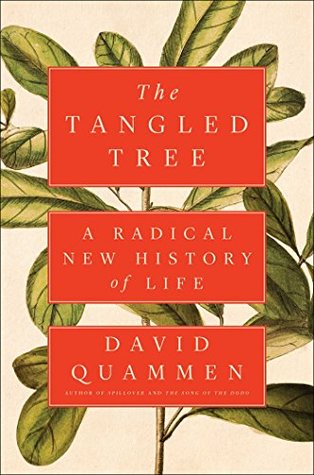More on this book
Community
Kindle Notes & Highlights
Read between
August 11 - August 31, 2019
Their DNA is part of your DNA—the part received exclusively from your mother. Why mother only? Because mitochondrial DNA is passed along via eggs and not via sperm.
Stammbaum was his word, a stem tree, a family tree, upon which every branch and twig represented a form of life evolved by natural selection from some other form of life—every form except, possibly, the very first and simplest. (He was still undecided, or anyway ambiguous in public, about whether life began from an act of God or a chemical accident. Later, he would opt for the latter.) And he made explicit what Darwin had hinted in The Origin: that this evolutionary process, this tree, included humans.
ontogeny recapitulates phylogeny.
“The kingdoms are man’s classification,” he added, and their meaning derives only from the fact that we humans choose to recognize them, purely for our convenience in organizing biological knowledge. This is similar to what he had said about plant communities: that the communities, as distinct from individual plants or populations of this species or that, have a “low degree of reality” in the tangible world. Plant communities are how we think about plant diversity, which tends to get arranged so that plants with similar needs share similar habitats. Kingdoms of life are how we think about
...more
Ivan Wallin and Lynn Margulis, among others who did study microbes, argued that symbiotic combining of one life-form with another had done more, in generating evolutionary novelty, than the incremental variations, the random mutations, that supposedly fueled natural selection.
reticulate evolution—the idea that the limbs of the tree of life are intertangled.
The concept of “species” is commonly supposed to be secure. It isn’t secure. It’s especially insecure in the realm of bacteria and archaea, but it’s even a bit blurry when scientists try to distinguish one species of plant or one species of animal from another. The boundaries blur. The edges are as porous as Goretex—or, in some cases, as cheese cloth. One reason for the blur, one symptom of the porosity, is horizontal gene transfer—genes moving sideways instead of just downward from parent to offspring. If genes cross the boundary between one species of bacteria and another, then in what sense
...more
This is radically different, Sonea and Panisset claimed, from evolution as described by Darwin, who focused on animals and plants. Animal and plant species, as well as other eukaryotic species, arise mainly by genetic isolation. Bacteria are never so isolated. Instead of tortoises and mockingbirds marooned on islands, mutating and adapting, diverging slowly into distinct subspecies and eventually new species, finally reaching a point where they can’t or won’t mate with other populations—instead of that, you have relentless bacterial togetherness. You have genes oozing sideways all over the
...more
broken DNA, as a cell fixes it, using ambient materials, may include bits that weren’t part of the original. If that mended DNA happens to be in cells of the germ line, the changes will be heritable. Baby rotifers will get them and, when the babies mature, pass the changes along to their own daughters. Thus a bacterial or fungal gene can become part of the genome of a lineage of animals.
Human cells are continually exposed to bacteria—the ones that live routinely in our guts and on our skin; the ones that infect us sometimes. That intimate juxtaposition has consequences. One consequence, unsuspected before but suggested by this Hotopp study in 2013, is that bits of naked bacterial DNA, possibly from broken-open bacterial cells, may often get integrated into cells (not necessarily germline cells) of a person’s body. Into cells of the stomach lining, for instance. Or blood cells. By “integrated,” what I mean is, not just absorbed or injected into the human cell but patched into
...more
“Each gene has its own history.” How was that possible? Horizontal gene transfer. While the creatures replicated themselves vertically—humans producing humans, yeast producing yeast, Haemophilus influenzae producing more Haemophilus influenzae—sometimes the genes went sideways. They had their own selfish interests and opportunities.
His pronouncement of the Archaea as the third great domain of life, revolutionary in 1977, had become an orthodoxy that he wanted to defend. This is what happens in science. Paradigms shift, but seldom twice in the life and mind of one scientist.
It offered the radical proposition that the universality of the code—all creatures using the same three-letter DNA combinations to call in the same amino acids—reflects a dynamic evolutionary process during the early history of life, not a “frozen accident” traceable to happenstance in one small population of universal ancestors, as Francis Crick had suggested. That proposition was supported in the paper by a computer model and a tonic dose of math. The dynamic process involved “non-Darwinian” mechanisms that made innovation sharing between different lineages possible—and not only possible but
...more
“that a great percentage of our own DNA is of viral origin.” The figure most commonly cited is 8 percent: roughly 8 percent of the human genome consists of the remnants of retroviruses that have invaded our lineage—invaded the DNA, not just the bodies, of our ancestors—and stayed. We are at least one-twelfth viral, at the deepest core of our identities. Consider that, Sapp urged.
“Our genes are not only our genes,” he said. “Our genes are also retroviral genes.”


